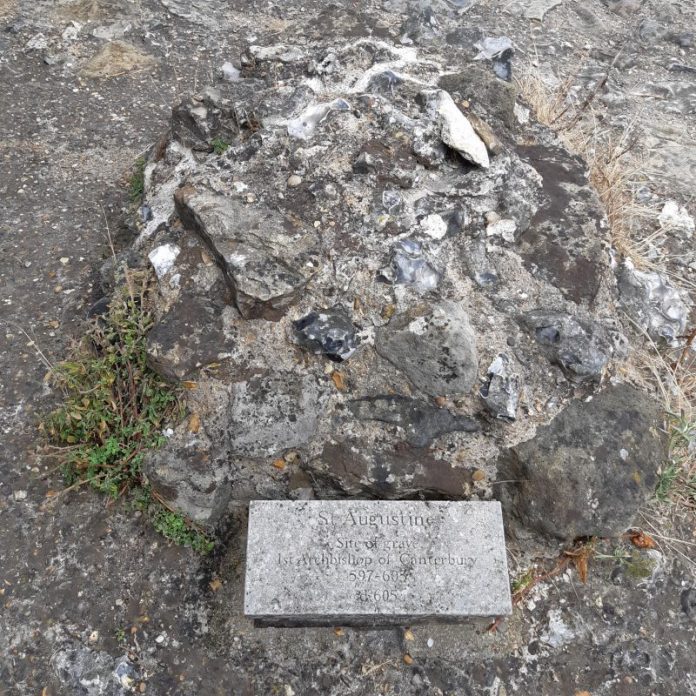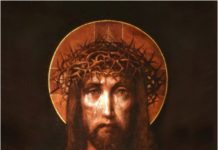As providence would have it, on this memorial of Saint Augustine of Canterbury – the ‘other’ Saint Augustine – who evangelized and solidified the Faith in England, another article by William Kilpatrick warning of the de-Christianization of the British island. There are two primary, and reciprocal, factors at play in its degradation: The secularization, even re-paganization, of Britain, LGBT, transgenderism, as it and its people lose its religious and cultural moorings.
Then we have, as Mr. Kilpatrick has repeatedly pointed out, the gradual, and gradually not so gradual, Islamization of the once-fair island, with universal Sharia law likely not far from the horizon.
Which one will win out in the end? As the adage goes, put your money on the stronger and more determined horse.
Here are some adapted thoughts I had on the great Saint Augustine upon my pilgrimage through Canterbury last summer.
The first bishop of Canterbury, Augustine (+604, pronounced in England, ‘Austin’, but not always, as I discovered was, like the ‘other’ Augustine, of Hippo in what is now northern Africa, was a citizen of the Empire. Neither would have considered himself ‘African’ or ‘Italian’, but Roman, for there was but one civilization, Roman and Catholic. As Hilaire Belloc points out, the whole notion of ‘nations’ came much later in history. Outside of the Empire, were the un-civilized, the barbarians.
So too, there was one ‘Church’ to which they belonged, the Catholic, outside of which there was paganism, the yet-to-be redeemed. There were no romantic notions, as the later, fervid atheistic imagination of Rousseau was to conjure up, of the ‘noble savage’.
Also, there were no (and still really are not) ‘denominations’ of Christians, and, as Newman discovered in his own historical research, Anglicanism did not come to be until after Henry VIII, its progenitor; as the Oratorian put it, to delve into history is to cease to be a Protestant.
Augustine, that is, of Canterbury (we now know him by the name of his See), seems to have originally belonged to the Benedictine monastery on the Coelian Hill in Rome, founded by Pope Gregory, the first pontiff of that name, later to be called ‘Great’, for a whole host of reasons.
One of those reasons was Gregory’s missionary zeal, for it was he who commissioned Augustine to convert Britain. Upon witnessing some ‘Angles’ being sold as slaves in a market place (who would give their name to ‘England’), Gregory was moved to do something, prompting him, in a play on words, to turn these ‘Angles’ into Angels, and not just them, but all the other tribes they would discover, the Saxons, Celts, Picts, all of those ‘outside the frontier’, for by the time of Gregory, the empire was not only civilized, but Catholic.
The Romans had spread abroad, through might and main, the material benefits of their culture, the whole codification of laws, military discipline and training, building techniques, plumbing and clean water, and sewage, literature, two refined and advanced languages (Latin and Greek) allowing for the advancement of thought and philosophy, as well as, while we’re at it, heated flooring and fine red wine.
They made a foothold in Britain, but the legionaries departed in 410, not to return, and the island had sunk to some degree back into barbarism. Irish missionaries had made some advance spiritually in the north of the island (see my reflections on Catholic Glasgow), but the south was largely unconverted.
So Gregory and Augustine, as both Roman and Catholic, wanted to offer the pagans, as they themselves had received, all the supernatural goodness that would perfect what natural foundation they had: the Church’s creed, her moral code, and a structured prayer and liturgical life, not least the Holy Eucharist (which is ultimately why all the cathedrals were built, and which holds everything else together), all of which produced a human flourishing, in this life but, more importantly, in the next.
Again, to Belloc, who declared quite emphatically that is was the Faith that built Europe.
Augustine and his merry band of stalwart missionaries went forth in year 597, landing on the isle of Thanet, where they were at first discouraged by the resistance of the pagan Angles; Augustine even returned to Rome, asking the Pope to be relieved. But the Pope, good father that he was, encouraged Augustine to persevere, and, good son that he was, the monk returned with his band of hearty followers.
I was intrigued to learn that what struck the people of Canterbury (about 18 miles from the coast, then called by its original Latin name of Durovernum) was the solemn procession of the monks into the town, these hardy, masculine, celibate men, completely dedicated to God, bearing the Cross and intoning in unison one of the ‘rogation’ litanies, in that beautiful and mystical Gregorian chant, named after the same Pope.
What a sight it must have been, and I don’t think the same impression would have been made with a band of lutes (that is, guitars) and drums, a sloppy procession, and a round of shaking hands, as one sees all too often in what passes for liturgy today, alas. Music, and by that I mean proper devotional music, has always been the greatest artistic treasure of the church, and a most fitting means of evangelization.
His queen already a Catholic, King Ethelbert was soon convinced by the teaching and example of the monks, and accepted baptism. Thousands of his people soon followed, and England, in a word, became Christian in the full ‘Catholic’, or universal, sense of that word.
The king gave them a grant of land outside the town, and the monks, as is their wont, got to building, tilling and cultivating; the impressive monastery ruins that stand to this day are a silent, but powerfully evocative, testament to what they accomplished. It was the monks who constructed, in more ways than physically, what was and is known as ‘Canterbury’.
The imposing cathedral, which dwarfs in size even modern skyscrapers, where Becket would be martyred near a side altar six centuries later, was constructed in the 12th century, itself a witness to the deep faith that had been instilled in the once-pagan ‘Angles’.
And so Canterbury and all of England remained, Catholic to the core, until the tragic years of 1535-40, when the Faith was all-but-obliterated from Britain; the fates of Buckfast and Walsingham also befell the Augustinian Abbey, handed over to the aforementioned King Henry VIII in his dissolution of the monasteries to fill his own fat coffers.
What Henry began in dismantling the Faith, is now almost complete, as what made England ‘England’ is disappearing, leaving in its wake…well, what?
As Louis XVI purportedly quipped, après mois, le deluge. And that inundation is already well underway.
We don’t need a new James Bond or Kingsmen – themselves part of the problem – but a new band of merrie saints like Augustine, who may once again sow the seeds of Faith, which will bear fruit amongst the wreckage, like sparks in stubble.












